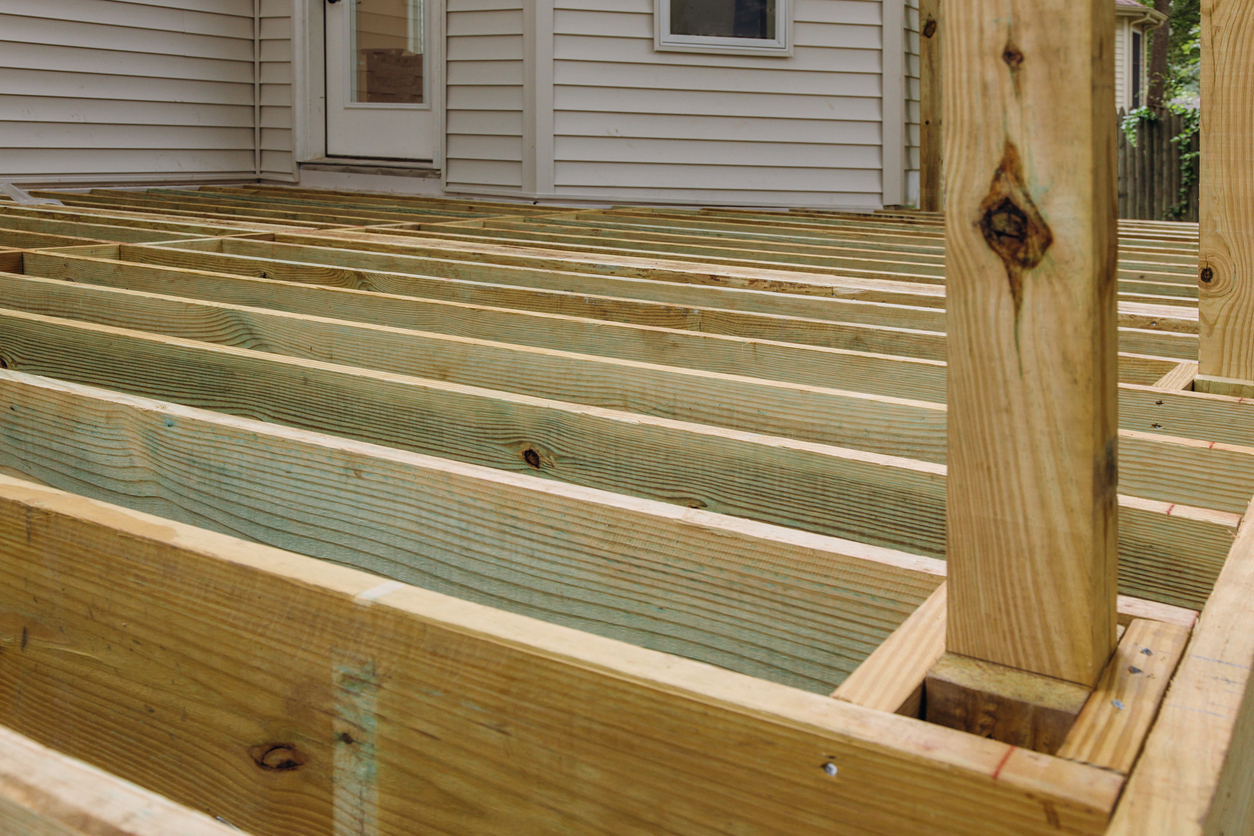

We may earn revenue from the products available on this page and participate in affiliate programs. Learn More ›
Decks and other outdoor spaces are different from ordinary rooms. They serve as an intermezzo between home and nature. The air is fresh. You can feel the sun’s warmth and smell the garden. Nature air-conditions outdoor rooms with soft breezes, and outdoor rooms are the perfect place to watch shadows grow and the stars come out on a summer night.
The beauty of a deck is that—unlike bare ground or lawn—it’s level, stable, supports furniture, sheds rain, and provides usable living space. Decks can serve as living rooms, breakfast rooms, exercise rooms, rooms for sunbathing, rooms for gatherings of friends and family, rooms for quiet times with a good book.
Building a deck, however, requires more skill and understanding of construction principles than, say, building a patio.
Deck Footings
The simplest deck, called an on-grade deck, typically requires the installation of concrete piers to which beams and joists are attached. The perimeter joists, called rim joists, are doubled and then covered with trim boards.
Depending on climate, the piers may need to be set on a footing that is several feet below grade. Check with your building department to find out what the code is in your area.
Proper footings prevent the deck from ‘heaving’ should the ground freeze. Framing hardware, such as post bases and joist hangers, are used to join all framing members. Decking (what you walk on) is fastened to the joists with screws or nails from the top, or with “invisible” fasteners from below.
An on-grade deck will probably be less than a foot off the ground and therefore will not require railings or stairs, both of which complicate construction significantly. A door to the house will also complicate things. If it’s a step above the decking, you’re in luck. If you have to build one two or three steps to reach the door, you’ll also probably want to include a landing to make entering and exiting the house safer and easier.
The higher a deck is off the ground, the more complex it is to design and build. Suddenly, you have to decide from which approach, or approaches, you’d like to access the deck. Skirting or landscaping must be used to hide the framing that supports the joists. Also, stair railings and balustrades must be built, adding to cost and complexity.

Deck Framing
Decks can range from simple platforms to multi-level projects using a variety of shapes and amenities. Openings in the deck surface can allow for plantings and incorporate elements of outdoor furniture. Decking may be parallel or diagonal. Tops of footings should extend 6 inches above ground and should be pitched outward to prevent water collection and inhibit decay and insects.
The deck framing tables shown below are for single spans of non-stress-graded Construction Heart and Construction Common redwood.
Suggested Beam Spans
Beam Spacing : Spans – Spans – Spans
6 feet: 4’0” – 5’0” – 7’0”
8 feet: 3’3” – 4’3” – 6’3”
10 feet: 3’0” – 3’9” – 5’6”
12 feet: 2’9″ – 3’6” – 5’0’
Suggested Joist Spans
Joist Size: Joist Spacing – Joist Span
2×6: 16” – on center – 7’3”
24” – on center – 6’0”
2×8: 16” – on center – 10’9”
24” – on center – 8’9”
2×10: 16” – on center – 13’6”
24” – on center – 11’0”
Concentrated loads of planters, spas, and other heavy objects may require additional joists and larger beams. Local building codes should be consulted regarding structural regulations.
Design loading, with deflection limited to L/180, sets a maximum two-foot span for 2-inch decking. Provide 1/8-inch minimum space between boards, and center all large knots and butt-jointed board ends over joists.
Beam span is the distance a beam extends from one post to the next. Beam spacing is the distance between beams. Deflection is limited to L/240.
Ledger Board & Flashing
If the deck is adjacent to the house, it will require a ledger board. Typically, siding is removed and the ledger board is bolted to the house framing. Flashing should then be installed so that rain and snowmelt don’t enter the joint between ledger and house. If the deck is a freestanding ‘island’ deck, there is no ledger board.

8×10 Deck Construction Example
The following small deck can make a big difference at a garden doorway, next to a retaining wall or under your favorite tree. It’s relatively easy to build and won’t cost too much either.
Deck Materials
Description / Quantity / Size / Length:
Posts / 6 pieces / 4×4 / varied
Skirtboard / 2 pieces / 2×12 / 10 feet
Skirtboard / 2 pieces / 2×12 / 8 feet
Ledgers / 2 pieces / 2×4 / 8 feet
Joists / 4 pieces / 2×8 / 8 feet
Deckboards / 26 pieces / 2×4 / 10 feet
Other Materials
Quantity / Description:
1 lb. / 16-penny nails
8 / 2×8 joist hangers
10 / 3/8×2-1/2-inch lag screws
10 / 3/8×6-inch carriage bolts, washers, and nuts
6 / Concrete footings with nail blocks
DIY Deck Building
Here are some basic things to remember when building a deck.
Attach joist hangers sixteen inches apart on center to the side rails. Lay out all floor joists and side rails, then nail them all at once using galvanized nails. Overhang the first floorboard by half an inch. If you have an enclosed deck or a screen porch, you can use tongue-and-groove flooring. Always try to use pressure-treated lumber for your deck frame.
Building a deck can greatly enhance the enjoyment of your yard, but spend time planning every step before pulling out your circular saw and nail gun. The nice thing about getting a deck under your belt, however, is that you’ll learn skills that will help when building many other projects, including garden sheds, porches, arbors and gazebos.
